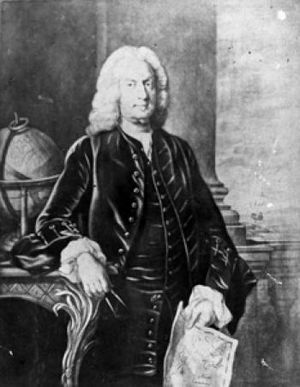Arthur Dobbs facts for kids
Quick facts for kids
Arthur Dobbs
|
|
|---|---|

Arthur Dobbs, c. 1753
|
|
| 7th Governor of North Carolina | |
| In office November 1, 1754 – October 27, 1764 |
|
| Monarch | |
| Preceded by | Matthew Rowan (acting) |
| Succeeded by | William Tryon |
| Personal details | |
| Born | April 2, 1689 Girvan, Scotland |
| Died | March 28, 1765 (aged 75) Brunswick Town, North Carolina |
| Resting place | St. Philip's Church, Brunswick Town 34°02′28.6″N 77°56′48.0″W / 34.041278°N 77.946667°W |
| Spouse | Anne Dobbs |
| Children | 4 |
| Military service | |
| Allegiance | |
| Branch | British Army |
| Years of service | 1711–1712 |
| Rank | Cornet |
| Unit | Echlin's Dragoons |
Arthur Dobbs (born April 2, 1689 – died March 28, 1765) was an important British official. He was the seventh governor of North Carolina from 1754 to 1764.
Contents
Arthur Dobbs' Early Life and Career
Arthur Dobbs was born in Scotland in 1689. His family was from Ireland. His great-great-grandfather, John Dobbs, built a home called Castle Dobbs in 1599.
Dobbs was a friend of the famous writer Jonathan Swift. He served briefly in the British Army as a soldier. After that, he managed his family's property.
He became the chief engineer and surveyor in Ireland. He helped build the Irish Parliament House in Dublin. He also worked on other public buildings in Ireland. In 1720, he became the Sheriff of Antrim. In 1727, he was elected to the Irish Parliament. He held this position until 1760.
While in Parliament, Dobbs bought a large amount of land in North Carolina in 1745. He encouraged people from Scotland and Ireland to move there. After the previous governor of North Carolina died, Dobbs was chosen to take his place in 1753. He arrived to start his job in October 1754.
Governor of North Carolina: A Challenging Role
As governor, Dobbs tried to create a permanent capital city for North Carolina. He wanted to call it George City. He even had plans for a grand governor's mansion. This mansion would have been similar to Tryon Palace, which was built later by the next governor.
Dobbs' time as governor was difficult. It was during the French and Indian War and the start of the American Revolution.
Protecting the Frontier
Soon after arriving, Dobbs visited the western parts of North Carolina. He helped build Fort Dobbs to protect settlers. He also tried to gather soldiers to fight in the French and Indian War. In 1758, he moved to Brunswick Town, North Carolina, where he lived for the rest of his life.
Conflicts with the Assembly
From 1759 to 1760, Governor Dobbs often disagreed with the local Assembly. There were problems with debt and Native American affairs. People also complained about agents working for Lord Granville. Dobbs also struggled to stop riots in places like Edgecombe County. He often rejected bills passed by the Assembly.
These disagreements caused a lot of tension. Dobbs even dismissed the Assembly in 1760 and called for new elections. However, this plan did not work well. A secret group made up serious charges against the governor to send to the King. Only the new King, George III, saved Dobbs from more conflict. The new King gave Dobbs more power.
Arthur Dobbs' Personal Life
In 1720, Dobbs married Anne, who was a widow. They had three sons and one daughter. Later, in 1762, when he was 73, Dobbs married Justina Davis, who was 15. They were married at St. Philip's Church, Brunswick Town.
A few months later, he had a stroke and needed a wheelchair. In 1763, he attended a meeting of southern governors and Native American tribes. This meeting led to the Treaty of Augusta.
In 1764, Dobbs planned to go back to England for a break. William Tryon arrived to take his place as acting governor. Dobbs later decided to retire and return to Ireland. However, while he was getting ready to leave, he had a fatal seizure on March 28, 1765. This was just two weeks before he was supposed to depart. He was buried at St. Philip's Church, but his grave is no longer marked.
Arthur Dobbs' Legacy
Arthur Dobbs left behind some important contributions.
Discovering the Venus Flytrap
In 1759, Arthur Dobbs wrote the first known description of the Venus flytrap. He wrote about this amazing plant in a letter to a botanist named Peter Collinson in 1760.
He described it as a "very curious unknown species of Sensitive." He noted its unique leaves that close "like an iron spring fox-trap" when something touches them. He called it the "Fly-trap Sensitive." This was before other naturalists gave it its scientific name, Dionæa muscipula.
Searching for the Northwest Passage
Dobbs was also very interested in finding a Northwest Passage. This was a sea route through the Canadian Arctic that explorers hoped would connect the Atlantic and Pacific oceans. He believed the Hudson's Bay Company was not doing enough to find it.
From 1741 to 1747, Dobbs helped encourage exploration. While a passage wasn't found, his efforts greatly increased our knowledge of the Arctic. They also showed the economic possibilities of the region. Dobbs was also an amateur scientist. He wrote articles about astronomy and even a pamphlet about honeybees.
Images for kids


